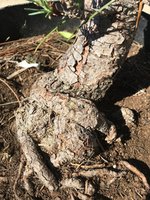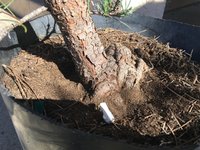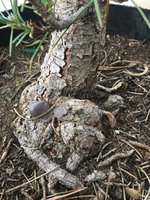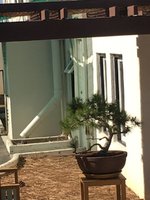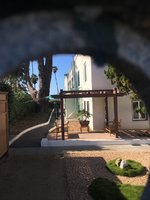Emanon
Mame
Hi all! A neighbor gifted me a nursery grown landscape pine tree that he had no use for. The roots are overlapping and, in general, are just a mass of mess. I was hoping to get advice as to whether (1) there is hope, and (2) what my next move should be.
I wasn't planning on taking it out of its nursery pot this year since I just cut back its trunk. Is it OK for me to just sever the roots that are overlapping now, while it is still in nursery pot?
The obvious root to cut (the one highest up) seems to be fusing and I was wondering if I did nothing, how bad would it look in the future (i.e. would it be in any way interesting or just ugly)? This is my first pine. Should I treat it like a maple, for example -- aiming for level radial roots, none overlapping?
Thank you so much for any advice -- I've never done this before!
P.S.- This is a Torrey pine. I know it is a bad species for bonsai. So, assuming this is true, what next?
I wasn't planning on taking it out of its nursery pot this year since I just cut back its trunk. Is it OK for me to just sever the roots that are overlapping now, while it is still in nursery pot?
The obvious root to cut (the one highest up) seems to be fusing and I was wondering if I did nothing, how bad would it look in the future (i.e. would it be in any way interesting or just ugly)? This is my first pine. Should I treat it like a maple, for example -- aiming for level radial roots, none overlapping?
Thank you so much for any advice -- I've never done this before!
P.S.- This is a Torrey pine. I know it is a bad species for bonsai. So, assuming this is true, what next?


